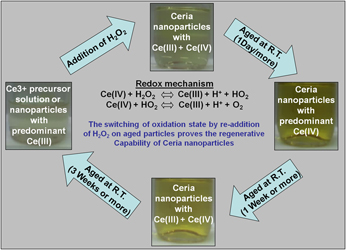Crossref Citations
This article has been cited by the following publications. This list is generated based on data provided by
Crossref.
Weng, Qinjie
Sun, Heng
Fang, Chunyan
Xia, Fan
Liao, Hongwei
Lee, Jiyoung
Wang, Jincheng
Xie, An
Ren, Jiafeng
Guo, Xia
Li, Fangyuan
Yang, Bo
and
Ling, Daishun
2021.
Catalytic activity tunable ceria nanoparticles prevent chemotherapy-induced acute kidney injury without interference with chemotherapeutics.
Nature Communications,
Vol. 12,
Issue. 1,
Lord, Megan S.
Berret, Jean Francois
Singh, Sanjay
Vinu, Ajayan
and
Karakoti, Ajay S.
2021.
Redox Active Cerium Oxide Nanoparticles: Current Status and Burning Issues.
Small,
Vol. 17,
Issue. 51,
Milenković, Ivana
Radotić, Ksenija
Despotović, Jovana
Lončarević, Branka
Lješević, Marija
Spasić, Slađana Z.
Nikolić, Aleksandra
and
Beškoski, Vladimir P.
2021.
Toxicity investigation of CeO2 nanoparticles coated with glucose and exopolysaccharides levan and pullulan on the bacterium Vibrio fischeri and aquatic organisms Daphnia magna and Danio rerio.
Aquatic Toxicology,
Vol. 236,
Issue. ,
p.
105867.
Neal, Craig J.
Sakthivel, Tamil Selvan
Fu, Yifei
and
Seal, Sudipta
2021.
Aging of Nanoscale Cerium Oxide in a Peroxide Environment: Its Influence on the Redox, Surface, and Dispersion Character.
The Journal of Physical Chemistry C,
Vol. 125,
Issue. 49,
p.
27323.
Zong, Zhifang
Chen, Depeng
Zhao, Chunxiao
Tang, Gang
Ji, Yilong
Zhang, Hao
and
Lv, Zhong
2021.
Application of Ce–Eu/TiO2 phase change material as the wall material to improve the indoor environment.
Journal of Materials Research,
Vol. 36,
Issue. 3,
p.
615.
Jiang, Lei
Tinoco, Miguel
Fernández-García, Susana
Sun, Yujiao
Traviankina, Mariia
Nan, Pengli
Xue, Qi
Pan, Huiyan
Aguinaco, Almudena
González-Leal, Juan M.
Blanco, Ginesa
Blanco, Eduardo
Hungría, Ana B.
Calvino, Jose J.
and
Chen, Xiaowei
2021.
Enhanced Artificial Enzyme Activities on the Reconstructed Sawtoothlike Nanofacets of Pure and Pr-Doped Ceria Nanocubes.
ACS Applied Materials & Interfaces,
Vol. 13,
Issue. 32,
p.
38061.
Lehnertz, Marcus S.
Mensah, Joel B.
and
Palkovits, Regina
2022.
Chemical recycling of polyhydroxybutyrate and polylactic acid over supported Ru catalysts.
Green Chemistry,
Vol. 24,
Issue. 10,
p.
3957.
Patel, Vaishwik
Jose, Linta
Philippot, Gilles
Aymonier, Cyril
Inerbaev, Talgat
McCourt, Luke R.
Ruppert, Michael G.
Qi, Dongchen
Li, Wei
Qu, Jiangtao
Zheng, Rongkun
Cairney, Julie
Yi, Jiabao
Vinu, Ajayan
and
Karakoti, Ajay S.
2022.
Fluoride-assisted detection of glutathione by surface Ce3+/Ce4+ engineered nanoceria.
Journal of Materials Chemistry B,
Vol. 10,
Issue. 47,
p.
9855.
Yadav, Nisha
Patel, Vaishwik
McCourt, Luke
Ruppert, Michael
Miller, Michael
Inerbaev, Talgat
Mahasivam, Sanje
Bansal, Vipul
Vinu, Ajayan
Singh, Sanjay
and
Karakoti, Ajay
2022.
Tuning the enzyme-like activities of cerium oxide nanoparticles using a triethyl phosphite ligand.
Biomaterials Science,
Vol. 10,
Issue. 12,
p.
3245.
Sun, Xinwei
Vøllestad, Einar
Rørvik, Per Martin
Prodinger, Sebastian
Kalantzopoulos, Georgios N.
Chatzitakis, Athanasios
and
Norby, Truls
2023.
Surface protonic conductivity in chemisorbed water in porous nanoscopic CeO2.
Applied Surface Science,
Vol. 611,
Issue. ,
p.
155590.
Sotoudeh Bagha, Pedram
Kolanthai, Elayaraja
Wei, Fei
Neal, Craig J.
Kumar, Udit
Braun, Gillian
Coathup, Melanie
Seal, Sudipta
and
Razavi, Mehdi
2023.
Ultrasound-Responsive Nanobubbles for Combined siRNA-Cerium Oxide Nanoparticle Delivery to Bone Cells.
Pharmaceutics,
Vol. 15,
Issue. 10,
p.
2393.
Wu, Yue
Zhang, Yawen
Tang, Xuanyu
Ye, Shuhui
Shao, Jingjing
Tu, Linglan
Pan, Junzhi
Chen, Lingfeng
Liang, Guang
and
Yin, Lina
2023.
Synergistic anti-oxidant and anti-inflammatory effects of ceria/resatorvid co-decorated nanoparticles for acute lung injury therapy.
Journal of Nanobiotechnology,
Vol. 21,
Issue. 1,
Fusek, Lukáš
Samal, Pankaj Kumar
Keresteš, Jiří
Khalakhan, Ivan
Johánek, Viktor
Lykhach, Yaroslava
Libuda, Jörg
Brummel, Olaf
and
Mysliveček, Josef
2024.
A model study of ceria–Pt electrocatalysts: stability, redox properties and hydrogen intercalation.
Physical Chemistry Chemical Physics,
Vol. 26,
Issue. 3,
p.
1630.
Gorban, Oksana
Shylo, Artem
Gorban, Sergii
and
Danilenko, Igor
2024.
Photosensitive Ag-contained CeO2-ZnO composites with non-stoichiometric matrix: Aspects of formation.
Journal of Alloys and Compounds,
Vol. 1002,
Issue. ,
p.
175276.
Dass, Baskaran Mohan
Neeshma, Maniprakundil
Unni, Sreekuttan M.
Dhavale, Vishal M.
Prabhakaran, Dhanasekaran
and
Bhat, Santoshkumar D.
2024.
Functionalized Ceria Nanoparticles Reinforced with Short Side Chain-Based Composite Membrane for Low-Humidity Hydrogen-Powered Fuel Cells.
ACS Applied Polymer Materials,
Vol. 6,
Issue. 19,
p.
11691.
Wang, Shulong
Huang, Wenfang
Lin, Qingyan
Feng, Yinyin
Wei, Qingmin
Xu, Jiayao
Wang, Rong
and
Luo, Zhihui
2024.
Design and synthesis of a novel chiral photoacoustic probe and accurate imaging detection of hydrogen peroxide in vivo.
Analytical and Bioanalytical Chemistry,
Vol. 416,
Issue. 23,
p.
5205.
Luque-Álvarez, Ligia A.
Núñez-Carballo, Ana
Lacroix, Bertrand
Sánchez-de-Armas, Rocío
Centeno, Miguel A.
Pastor-Pérez, Laura
Bobadilla, Luis F.
and
Odriozola, José A.
2025.
Exploring the impact of nanoshaped ceria in the methanol decomposition reaction pathway for clean energy production.
Applied Catalysis B: Environment and Energy,
Vol. 361,
Issue. ,
p.
124649.



